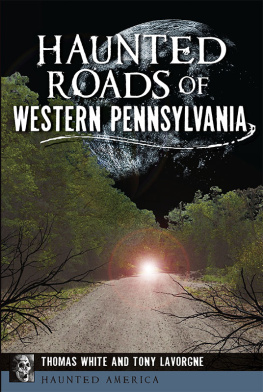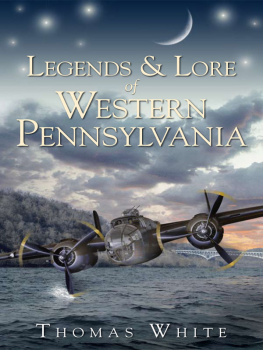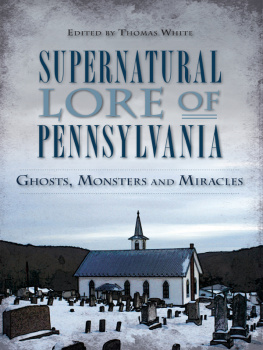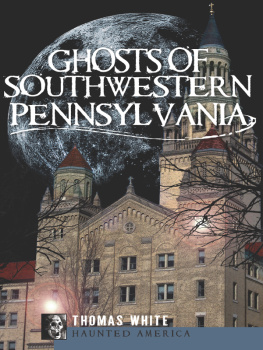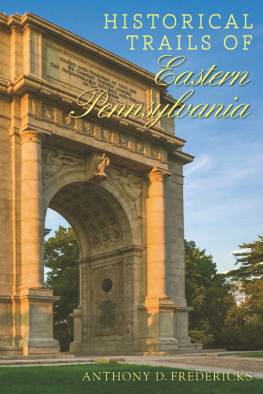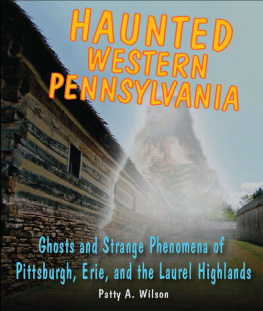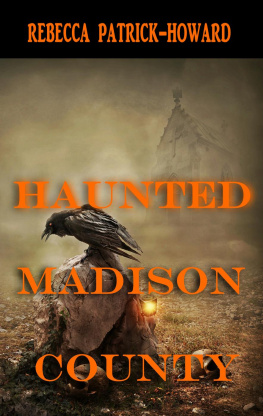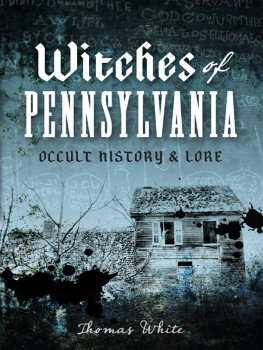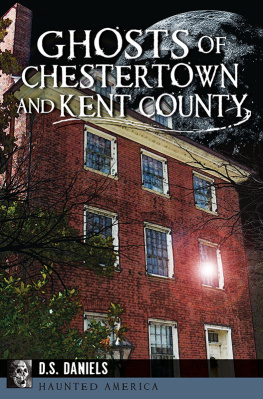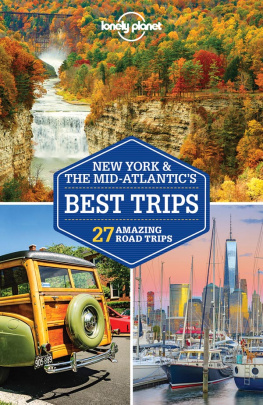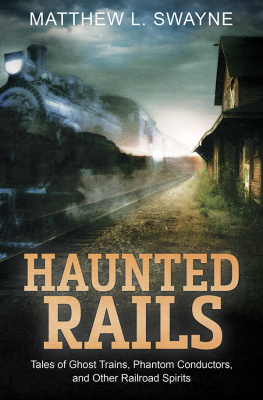

Published by Haunted America
A Division of The History Press
Charleston, SC 29403
www.historypress.net
Copyright 2015 by Thomas White and Tony Lavorgne
All rights reserved
First published 2015
e-book edition 2015
ISBN 978.1.62585.598.5
Library of Congress Control Number: 2015943862
print edition ISBN 978.1.46711.816.3
Notice: The information in this book is true and complete to the best of our knowledge. It is offered without guarantee on the part of the author or The History Press. The author and The History Press disclaim all liability in connection with the use of this book.
All rights reserved. No part of this book may be reproduced or transmitted in any form whatsoever without prior written permission from the publisher except in the case of brief quotations embodied in critical articles and reviews.
For Justina and Maureen
CONTENTS
ACKNOWLEDGEMENTS
Many people assisted us in a variety of ways while we were working on this book, and their help was greatly appreciated. We would like to thank our wives, Justina and Maureen, and children, Tom and Marisa, for their continued support and patience. Also our extended families for their support and encouragement. Brian and Terrie Seech opened up their extensive archive to us, and we appreciate their help. We would also like to thank Victoria Trimble, Stephen Bosnyak, John Schalcosky of the Ross and West View Historical Societies, Amy Steele at Northland Library, Ed Falvo and the Elizabeth Township Historical Society, the Mercer County Historical Society, the Lawrence County Historical Society and Carly Lough at the Heinz History Center for their help accessing images and information. Many other people contributed by giving us stories, helping with editing or in other ways, including Haley Bristor, Colby Collins, Brian and Lori Mckee, Kurt Wilson, Andy Grejda, Ashley Kilbert, Anthony Kilbert, Emily Jack, Gerry ONeil, Ariel Hammel, Kyle and Carrie Payne, Elisa Astorino, Allison Brungard, Debbie Brungard, Jennifer Germeyer, Katie Barbera, Jamie Thomas, Joshua Maley, Jim Matuga, Hannah Palmer, Megan DeFries, Albert DiAmicis, Michael Hassett, Will and Missy Goodboy, Vince Grubb, Brian and Jen Hallam, Ken Whiteleather, Rebecca Lostetter, Dan Simkins, Brett Cobbey, Chelsea Binnie, Angelle Pryor and Michael Witherel, Cassandra Speicher and Hailey Flowers of Coffee Buddha. Also, we would like to thank Hannah Cassilly and the rest of the staff of The History Press for giving us the opportunity to write this book.
Introduction
WHY GO TO A HAUNTED ROAD?
You probably heard the stories while you were growing up. Maybe it was a friend that told you or an older brother or sister. If you are of a younger generation, perhaps you stumbled across them on the Internet one fall day while you were looking for something exciting to do as Halloween approached. Regardless of how the tales came to you, they sparked something in your imaginationa sense of mystery, adventure and even a little fear. The stories that you heard surrounded a very real but ill-defined place on the periphery of your daily worlda place that, if located elsewhere, would not warrant a second thought. But out there, in the darkness beyond the streetlights and housing plans, that place could be home to both wonders and horrors. More importantly, it was a place where you could go and attempt to experience the supernatural.
That place is, of course, a haunted road.
Maybe the stories and legends that you heard told of the ghosts of children who lost their lives in a fire at their orphanage or a family killed in a tragic car accident. If you sought them out, they would leave tiny handprints on your car or push it back up the road. Or perhaps you heard that the Ku Klux Klan or satanic cults gathered along the dark road for rituals, sacrifices and murder. Their victims ghosts (and any dark spirits they summoned) lingered there in the darkness. Speaking of murder, you may have heard about a man who killed his wife or family in an old house along the road. Unable to move on, their spirits stay at the scene of the crime. Of course, the stories may have been a little vague, telling of an evil force that drives animals, and maybe even people, crazy if they stay too long. Its possible you heard something else that was equally as creepy or sinister or a combination of all of these events.
The particular story itself may not have been as important as the possibility it presented. Out there was the opportunity to interact with something that was beyond the normal and rational. It was not a television show, documentary or a movie. Nor was it a distant ruin or some haunted mansion. It was an accessible place where you could go to test the reality of the supernatural. You needed to do nothing other than travel to the haunted road and perform any activity that the legend promised would provoke a supernatural response.
So, you might have gathered some friends and set out on a nighttime trip, recounting the stories along the way. The level of seriousness depended on the people involved. Jokes were probably intermixed with personal accounts or speculation about paranormal phenomena. After arriving at the dark and desolate road, you proceeded cautiously by car or on foot, looking for a particular location or landmark mentioned in the accounts as the dramatic tension built. Finally, you found what you were looking for and performed the action that the stories insisted would cause the ghosts to appear. Maybe you put your car in neutral, or called a name three times, or flashed your headlights, or something else that would normally be innocuous. Then it happened. You heard a noise in the woods, or you saw a strange light, or your car started to move. Your friends may have wanted to leave immediatelyor maybe you tried to wait and see what it was. But something else happenedmaybe another noiseand everyone fled the scene quickly.
When you were finally off of the road and driving away, the speculation began. What had actually occurred? Did you encounter a ghost? Was someone playing a prank? Did you misinterpret normal noises? The answers were not clear. The only thing that you were sure of was that something happened.
In the weeks that followed, you probably recounted the stories of the haunted road numerous times to friends and acquaintances. But now it was your own personal experience at the center of the narrative. Your trip had made you part of the legend, at least for a while.
Many of us have had experiences like the one that was just described. Making the trip to a haunted place is a rite of passage for many adolescents. Teenagers are not the only ones who take these kinds of trips, however. In todays culture, saturated with the paranormal, adults are just as likely to make the trip to a haunted place. This book will explore the supernatural legends, hauntings and personal encounters of those who have made the dark journey down western Pennsylvanias haunted roads. We will try to examine the evolving legends associated with these roads and the historical context in which they formed. Besides being entertaining, supernatural legends and ghost stories can tell us a lot about society and the communities in which they emerge. As with most things, they are more complicated than they initially appear.
You may ask why we chose to focus on roads as opposed to graveyards, homes or some other type of location. Ghost stories and supernatural legends can appear almost anywhere after all, so what makes roads special? A main reason (aside from purely personal interest) that we chose to focus on roads was their accessibility. Most roads are public areas, unlike buildings, institutions or even cemeteries (which usually close at dusk.) You do not need to make an appointment to go to a haunted road, and generally, if you do not venture onto private property, you are allowed to be there. These conditions make roads the most democratic of haunted locations because they are potentially available to the largest number of people. Of course, along with accessibility comes a greater number of reports of supernatural encounters that create a greater depth to the legend.
Next page
